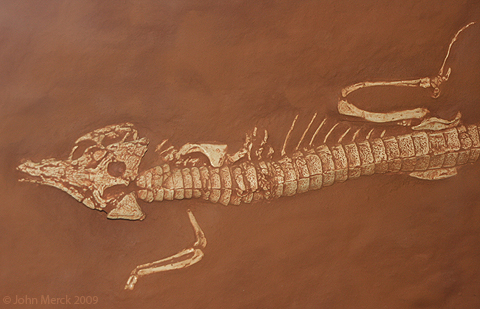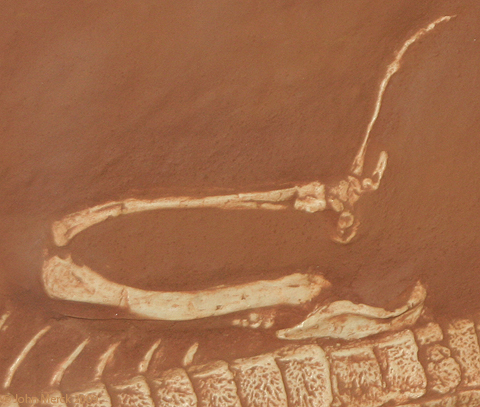[Recent Entries][Archive][Friends][User Info]
April 27th, 2012
| April 27th, 2012 | |
|---|---|
| 07:37 pm [industrialterro] [Link] |
Dibothrosuchus Dibothrosuchus is a genus of sphenosuchian, a type of basal crocodylomorph, the clade that comprises the crocodilians and their closest kin. It is known from several partial skeletons and skulls. These fossils were found in Lower Jurassic rocks of Yunnan, China. Dibothrosuchus was a small terrestrial crocodylomorph that probably had a keen sense of hearing, and thus was likely a vocal animal like modern crocodilians. Dibothrosuchus was named in 1965 by D.J. Simmons based on a partial skull and skeleton collected by Father Oehler of Fu Jen Catholic University from mudstones near the village of Dawa. The type species is D. elaphros. Additional remains of this genus were recovered in 1985 by a joint Chinese-US expedition. Fossils of Dibothrosuchus come from the lower Lufeng Formation (the Dark Red Beds). At least three partial skeletons and two skulls are known, along with isolated bones. Dibothrosuchus was first described as an ornithosuchid thecodont, but it was later reclassified as a sphenosuchid sphenosuchian. A second species, D. xingsuensis, was named by Wu in 1986. After reexamination of the holotype Wu and Chatterjee found D. xingsuensis to be a synonym of D. elaphros, leaving only one species in the genus. Dibothrosuchus was not a large animal. From the tip of the snout to the occipital condyle, the skull of IVPP V 7907 is only 164 millimetres (6.5 in) long, and the body length of the individual is estimated as 1.3 metres (4.3 ft). In general form, Dibothrosuchus was a slender, long-tailed and long-limbed quadruped with a pointed snout. Unlike modern crocodilians, it was a terrestrial animal. The upper jaws had five small teeth per premaxilla (snout-tip bones) and seventeen per maxilla, with a small hole between the maxilla and premaxilla for an enlarged tooth in the lower jaw to fit. At least eleven teeth were present on each side of the lower jaw. Several small ridges were present on the top of the skull. The various parts of the skull that supported hearing were well-developed, indicating that Dibothrosuchus had a keen sense of hearing and likely was a vocal animal that could communicate with others of the same genus, like modern crocodilians. Two rows of armor plates ran along the midline of the spine.
Tags: Вымершие рептилии, Юра, архозавроморфы, архозавры, диапсиды, крокодиломорфы, круротарзы, равизухии, сфенозухии |
| Time | Event |
| 07:51 pm [industrialterro] [Link] |
Pedeticosaurus Pedeticosaurus (van Hoepen, 1915) is an extinct genus of sphenosuchian crocodylomorph from the Clarens Formation (Early Jurassic) of South Africa. The type species is P. leviseuri. With long slender limbs, it was similar in form to other sphenosuchians, such as Saltoposuchus and Terrestrisuchus. Van Hoepen originally established a new family for it, the Pedeticosauridae.
Tags: Вымершие рептилии, Юра, архозавроморфы, архозавры, диапсиды, крокодиломорфы, круротарзы, равизухии, сфенозухии |
| Time | Event |
| 08:01 pm [industrialterro] [Link] |
Protosuchus Protosuchus is an extinct genus of carnivorous crocodylomorph from the Early Jurassic. The name Protosuchus means "first crocodile", and is among the earliest animals that resemble crocodilians. Protosuchus was about 1 metre (3.3 ft) in length and about 40 kilograms (88 lb) in weight. As an early crocodile relative, its skull featured more crocodilian characteristics than its earlier ancestors; it had short jaws that broadened out at the base of the skull, providing a large surface to which its jaw muscles could attach. This increased the maximum gape of the animal's mouth and the force with which the jaws could be closed. The dentition of the animal also resembled modern crocodiles, including the teeth in the lower jaw that fitted into notches on either side of the upper jaw when the mouth was closed. It also possessed a powerful tail which later developed into a propulsion mechanism through water in its descendants. The body was covered and reinforced by scales, and along of the back was a double row of bony plates. It was an unusual quadrupedal reptile whose legs were columnar, with the rear legs longer than the front legs. Its five toes were clawed and it is believed that they were good runners and good swimmers. Протозухии (Protosuchia) — группа архаичных вымерших наземных крокодиломорф, обитавших в мезозойскую эру. Архаичных крокодилов впервые выделил в особую группу венгерский палеонтолог Ференц Нопча, назвавший их прокрокодилами (Procrocodylia). Собственно протозухии в то время почти не были известны, и в группу прокрокодилов вошли преимущественно теперешние сфенозухиды. Наименование «Protosuchia» архаичные крокодилы получили после описания первого североамериканского их представителя Protosuchus. Американский палеонтолог Альфред Ромер в 1960-е годы считал, что сам Protosuchus — аберрантная форма, которая слишком глубоко эволюционировала в сторону наземного образа жизни, чтобы быть предком настоящих крокодилов, и установил для «настоящих» предков новый подотряд Archaeosuchia, в котором объединил род Proterochampsa из среднего триаса Аргентины с тремя малоизвестными родами из верхнего триаса Южной Африки и нижней юры Китая (семейство Notochampsidae). Английский палеонтолог Стил в 1970-е годы для архаичных крокодилов признавал два отдельных подотряда — Protosuchia (сфенозухиды и протозухиды) и Archaeosuchia (нотохампсиды и протерохампсиды). В настоящее время археозухий в особый подотряд обычно не выделяют. Протозухии — небольшие четвероногие ящеры длиной 1-1,5 м. У протозухий сохраняются длинные конечности, так что, по-видимому, это были в основном обитатели суши, но по общему виду и конфигурации черепа они больше, чем сфенозухии, напоминают современных крокодилов. Верхнее височное отверстие и предглазничное окно сильно редуцированы. Теменные кости сливаются по всей средней линии, а заднеглазничная и заднелобная образуют единое окостенение. Как и у сфенозухий, клыковидные зубы нижней челюсти находятся в углублении между предчелюстной и верхнечелюстной костями. Нёбо более пластиновидное, чем у сфенозухий, и нёбные кости составляют часть вторичного нёба. У Protosuchus крыловидные кости плоские и полностью слиты по средней линии, но у Notochampsa они желобчатые, что указывает на простирание между ними покрытых мясистым вторичным нёбом носовых проходов до уровня горла. Квадратная кость прочно соединена с боковой стенкой мозговой коробки. У Eopneumatosuchus можно видеть в основном современный тип пневматизации черепа. В посткраниальном скелете мало признаков, отличающих протозухий от современных крокодилов, за исключением неглубоко амфицельных позвонков на протяжении всего позвоночника. Пятая метатарсалия редуцирована до мелкого фрагмента. Коракоид удлинён, хотя не в такой степени, как у современных крокодилов. Лобковая кость не участвует в образовании вертлужной впадины, но всё же достигают её края. Седалищные кости разрастаются вперёд. Спинной панцирь состоит из парного ряда прямоугольных пластин. Протозухии распространены космополитично и известны в Южной Америке (Hemiprotosuchus), Южной Африке (Notochampsa и Pedeticosaurus), Северной Америке (Stegomosuchus и Protosuchus) и Китае (Dianosuchus). Судя по известным ископаемым останкам, протозухии представляют собой чётко очерченную группу, по-видимому характеризовавшуюся более выраженным наземным образом жизни, чем у современных крокодилов, но менее специализированную для бегательной локомоции, чем сфенозухии. Длительное время считали, что у всех протозухий верхнетриасовый возраст, и это чётко отделяет их по времени от мезозухий, появившихся в конце нижней юры. В настоящее время признаётся, что все протозухии, за исключением Hemiprotosuchus, происходят из отложений нижней юры. Они древнее мезозухий, но, что более важно, чётко отличаются от них по местообитаниям. Все протозухии известны из отложений, ясно свидетельствующих об их сухопутном образе жизни, и тесно связаны с останками динозавров. Наиболее ранние мезозухии обнаружены в морских отложениях вместе с ихтиозаврами и плезиозаврами и специализированы для локомоции и питания в воде.
Ископаемые останки (1, 2, 3, 4):
Tags: Вымершие рептилии, Юра, архозавроморфы, архозавры, диапсиды, крокодиломорфы, круротарзы, протозухии, равизухии |
| Time | Event |
| 08:34 pm [industrialterro] [Link] |
Sichuanosuchus Sichuanosuchus is an extinct genus of crocodylomorph from the Late Jurassic and possibly Early Cretaceous of China. Mesoeucrocodylia is the name of the clade that includes Eusuchia and the paraphyletic group Mesosuchia. The group appeared during the Early Jurassic, and continues to the present day. It was long known that Mesosuchia was an evolutionary grade, a hypothesis confirmed by the phylogenetic analysis of Benton and Clark, 1988 which demonstrated that Eusuchia (which includes all living crocodylian species) was nested within Mesosuchia. As the authors did not accept paraphyletic groups, Mesoeucrocodylia was erected to replace Mesosuchia. Several anatomical characteristics differentiate Mesoeucrocodylia from the other crocodylomorph clades. The frontal bones of the skull are fused together into a single compound element, for example. Mesoeucrocodylians possess somewhat of a secondary palate, formed by the posterior extension of sutured palatine bones. The otic aperture of the members of this clade is blocked posteriorly by the squamosal bone.
Tags: Вымершие рептилии, Юра, архозавроморфы, архозавры, диапсиды, крокодиломорфы, круротарзы, мезоэукрокодилии, равизухии |
| Previous Day | 2012/04/27 [Archive] |
Next Day |











